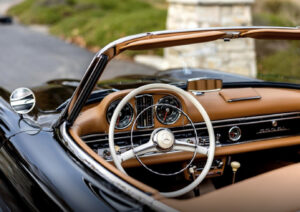
The name 300SL conjures visions of aviation-inspired gullwing doors, polished aluminum finishes, and a postwar German economy daring to dream again. But in 1957, Mercedes-Benz did something bold: it took the roof off its most iconic car. With the introduction of the 1957 300SL Roadster, Mercedes-Benz didn’t just create a convertible—it introduced an entirely new attitude for its engineering marvel. Gone were the signature gullwing doors; in their place came open-air freedom, road-focused usability, and refinements that made the SL not just a sports car, but a grand tourer.
Origins: Closing the Gullwings, Opening the World
The 300SL Gullwing Coupé (1954–1957) had already cemented its place in automotive lore as the fastest production car in the world, clocking over 160 mph thanks to its advanced 3.0-liter straight-six engine with Bosch mechanical fuel injection. Its tubular spaceframe was revolutionary—lightweight yet strong—but it necessitated those legendary gullwing doors due to high side sills.
As public demand shifted toward more luxurious and user-friendly driving experiences, especially in the booming American market, Mercedes-Benz responded by developing the 300SL Roadster (W198 Series II). Introduced at the Geneva Motor Show in March 1957, the Roadster was not a mere variant—it was an entirely reengineered automobile.
Engineering Revisions: Under the Skin
While the 300SL Roadster retained the same 2996cc M198 inline-six engine from its Coupé sibling, engineers made several key refinements to suit the Roadster’s dynamic and usability goals.
- Revised Spaceframe: The high sills of the Coupé were lowered, allowing for conventional doors and better ingress/egress. This required a complete reconfiguration of the spaceframe around the cockpit area without compromising rigidity.
- Improved Rear Suspension: The swing-axle rear suspension was modified to a lower-pivot design, improving cornering stability and reducing the lift-off oversteer that plagued early Gullwings.
- Disc Brakes (from 1961): Though the early Roadsters retained drum brakes, later models (from mid-1961 onward) were fitted with four-wheel Dunlop disc brakes, bringing the SL in line with rapidly evolving performance standards.
These mechanical changes didn’t just make the car safer or more comfortable—they made it a truer road car, without sacrificing its motorsport DNA.
Design Evolution: From Fighter Jet to Yacht Deck
Aesthetically, the Roadster softened the Gullwing’s purposeful aggression. The coupé’s roofline and verticality gave way to a more fluid and elegant silhouette. With the top down, the long hood and rear deckline were accentuated, giving the car a yacht-like stance—long, low, and lean.
- Soft Top Integration: A manually operated folding canvas top tucked cleanly behind the cockpit. The optional removable hardtop added weather protection without sacrificing the Roadster’s flowing lines.
- Interior Refinement: The cabin was reupholstered with more luxurious materials, and cabin ergonomics improved. A revised dashboard, upgraded gauges, and optional Becker radios brought the car into line with the lifestyle aspirations of its buyers.
- Color Options: While silver with red interior remains the most iconic configuration, the Roadster was available in a range of custom color combinations, including rich blues, greens, and metallics—many paired with tan or parchment interiors.
Overall, the 1957 300SL Roadster was less a track-bred thoroughbred and more of a rolling sculpture—one equally at home on the winding roads of the Amalfi Coast or parked in front of the Hotel du Cap-Eden-Roc.
Cultural Context: Hollywood, Jet Set, and Global Reach
Where the Gullwing had been a machine of engineering dominance, the Roadster was a car of glamour. It was driven by royalty and rock stars, moguls and mid-century fashion icons. Sophia Loren, Pablo Picasso, and even Elvis Presley were photographed near or behind the wheel of a 300SL Roadster.
In the United States, its largest market, the car appealed to affluent buyers who wanted exclusivity without compromise. It offered both open-air touring and serious performance in a time when American convertibles emphasized excess over refinement.
Mercedes-Benz produced 1,858 Roadsters between 1957 and 1963, making it rarer than many contemporaries, though more numerous than the original Gullwing Coupé. As safety regulations and performance demands increased through the 1960s, the SL’s successor—the W113 “Pagoda”—would adopt a completely different design ethos. But the 300SL Roadster remained a transitional icon, bridging two worlds: racing pedigree and Riviera romance.
Driving Impressions: Then and Now
For those lucky enough to pilot an original 1957 300SL Roadster, the experience is visceral and poetic. The engine note is raspy, mechanical, and alive; the mechanical fuel injection system gives an almost race-car-like throttle response. Despite its age, the car feels fast—thanks to nearly 215 horsepower and a sub-7-second 0–60 time.
Modern restorers and collectors often retrofit the drum brake versions with disc setups or adjust suspension geometry for improved balance, but the essence remains. It’s a car that asks the driver to participate—manual steering, long-throw shifter, firm clutch—but rewards with every curve and sweep of the road.
Collectibility and Bequest
Today, the 1957 Mercedes-Benz 300SL Roadster is one of the most valuable and sought-after vintage automobiles in the world. Mint-condition examples regularly fetch prices exceeding $1 million at auction, with rare color configurations or factory hardtops commanding even higher premiums.
But its legacy transcends monetary value. The 300SL Roadster represents a moment in time when engineering, elegance, and aspiration aligned. It is a reminder that even the most revered designs can evolve—without losing soul.
Wind in the Past, Eyes on the Future
The 1957 Mercedes-Benz 300SL Roadster is not just a convertible version of a famous coupé. It is a reinvention. A recalibration of speed, style, and grace for an audience less concerned with lap times and more enthralled by the open road.
In removing the roof, Mercedes-Benz revealed not just the sky above—but a whole new horizon for what performance luxury could mean. Nearly seven decades later, the car still inspires awe, not because it’s perfect—but because it redefined what it meant to drive beautifully.
No comments yet.









